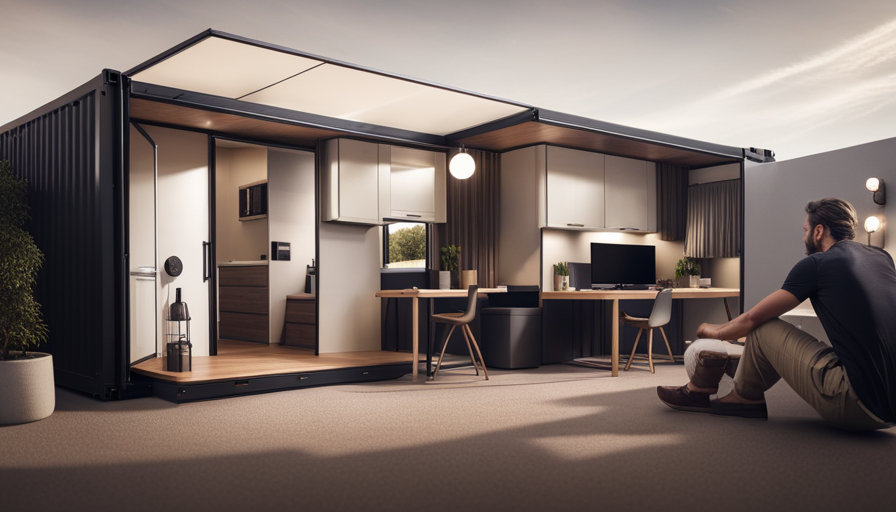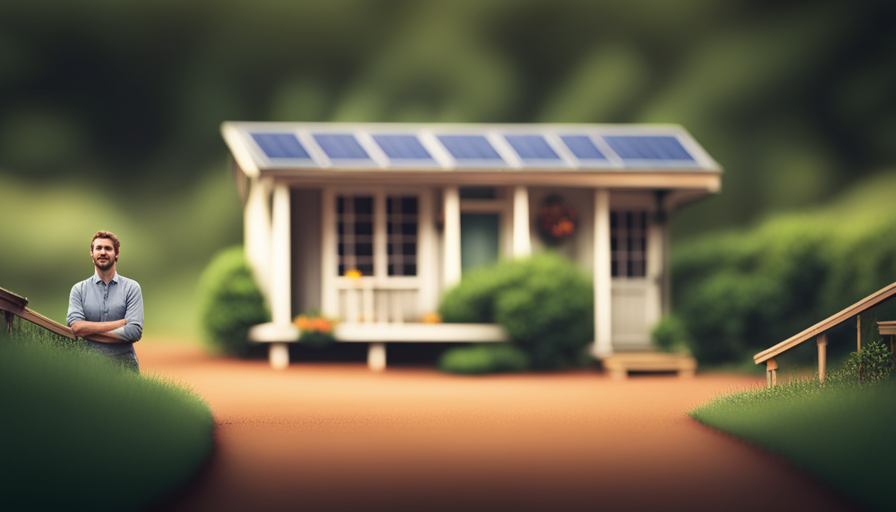Have you ever imagined living in a home that is as compact and efficient as a Swiss army knife? Look no further than container tiny houses! These unique homes are similar to the Transformers of the housing industry, capable of transforming from a basic steel box into a charming and fashionable residence.
But just how much do they cost? In this article, I will delve into the nitty-gritty details of container tiny house pricing, exploring the various factors that contribute to their overall cost. From the materials used in construction to labor costs and even resale value, we will leave no stone unturned.
So, if you’re curious about the financial aspects of container tiny houses and want to know if they’re a worthwhile investment, join me on this journey as we unbox the world of container tiny house economics. Get ready to be amazed at the possibilities that these miniature homes have to offer!
Key Takeaways
- Container tiny houses are compact and efficient homes made from steel containers, often using materials like recycled wood and bamboo for flooring and interior finishes.
- The cost of container tiny houses can be reduced by hiring a contractor or choosing a DIY option, with DIY options potentially saving up to 50% compared to hiring a contractor. However, additional expenses for plumbing and electrical work should be considered.
- Shipping costs for container tiny houses depend on factors such as distance, size, weight, and delivery method.
- Site preparation and construction for container tiny houses involve clearing land, leveling ground, and preparing utilities, with permits and zoning regulations needing to be navigated. A solid foundation is important for stability and durability.
Materials Used in Construction
When it comes to building a container tiny house, you might be surprised by how much they can do with the materials they use! Container tiny houses are typically constructed using different types of materials that provide both durability and functionality.
One of the most common materials used is Corten steel, which is known for its high strength and resistance to corrosion. This type of steel ensures that the container can withstand harsh weather conditions and remain structurally sound over time.
Additionally, container tiny houses often incorporate eco-friendly materials such as recycled wood or bamboo for flooring and interior finishes. These materials not only add a touch of warmth and aesthetic appeal to the space but also promote sustainability.
Transitioning into the next section about labor costs, the choice of materials plays a crucial role in determining the overall cost of building a container tiny house.
Labor Costs
When considering labor costs for a construction project, there are a few key points to keep in mind.
First, hiring a contractor can be a convenient option as they have the necessary experience and expertise.
However, for those who are more hands-on and willing to put in the effort, DIY options can lead to significant savings.
It’s also important to factor in additional expenses for plumbing and electrical work, as these are essential components of any construction project.
Hiring a contractor
To ensure your container tiny house is built to your exact specifications, hiring a contractor is essential. When hiring a contractor for your container tiny house project, it’s important to carefully consider your budget and plan accordingly.
Research potential contractors and obtain multiple quotes to compare prices and services offered. Keep in mind that while hiring a contractor may increase your overall costs, it can save you time and ensure a high-quality build. A contractor will have the necessary expertise and experience to handle all aspects of the construction process, from obtaining permits to coordinating with subcontractors. They can also provide valuable advice and guidance throughout the project.
By hiring a contractor, you can have peace of mind knowing that your container tiny house will be built professionally and efficiently.
Transitioning to the next section, let’s explore the DIY options and potential savings.
DIY options and savings
If you’re looking to save money, DIY options for building a container tiny house can be a cost-effective alternative, with some builders reporting savings of up to 50% compared to hiring a contractor. Here are four reasons why DIY can be a great option:
-
Flexibility: Building your own container tiny house allows you to have complete control over the design and customization. You can create a space that perfectly fits your needs and preferences.
-
Learning Experience: DIY projects offer a great opportunity to learn new skills and gain valuable knowledge about construction and design. It can be a rewarding experience to see your vision come to life.
-
Cost Savings: By doing the work yourself, you can eliminate the labor costs associated with hiring a contractor. This can significantly reduce the overall cost of the project.
-
Sense of Accomplishment: There’s a unique sense of pride and satisfaction that comes with completing a DIY project. Building your own container tiny house can be a fulfilling journey from start to finish.
When considering the cost comparison between DIY and hiring a professional contractor, it’s important to also factor in additional expenses for plumbing and electrical work.
Additional expenses for plumbing and electrical work
One important aspect to consider is that DIY options for building a container tiny house can bring unexpected expenses for plumbing and electrical work, which may add to the overall cost. When it comes to plumbing, you’ll need to factor in the cost of materials such as pipes, fittings, and fixtures, as well as the labor required to install them. This can vary depending on the complexity of your design and the specific plumbing requirements.
Similarly, electrical expenses can include the cost of wiring, outlets, switches, and any necessary electrical panels or circuit breakers. Hiring a professional electrician is highly recommended to ensure safety and compliance with building codes. Keep in mind that these additional expenses for plumbing and electrical work can significantly impact your budget.
Moving on to the next section about ‘location and delivery’, it’s important to consider the logistics of transporting and placing your container tiny house.
Location and Delivery
When it comes to the location and delivery of a container tiny house, there are several key points to consider.
Firstly, shipping costs can vary depending on the distance and method of transportation.
Secondly, site preparation and foundation are important factors to ensure the stability and safety of the house.
Lastly, permits and zoning regulations play a crucial role in determining where the house can be placed and what restrictions may be in place.
It’s important to carefully consider these factors when planning for the location and delivery of a container tiny house.
Shipping costs
Shipping costs for your adorable little container tiny house may just make you want to cry into your miniature pillow. However, it’s important to consider all the factors involved before jumping to conclusions.
Here are a few things to keep in mind when it comes to shipping costs:
-
Distance: The farther your tiny house needs to travel, the higher the transportation fees will be. Consider the distance from the manufacturing site to your desired location.
-
Size and weight: The dimensions and weight of your container tiny house will also affect the shipping costs. Larger and heavier units may require specialized transportation, which can add to the overall expenses.
-
Delivery method: The method of delivery you choose can impact the shipping costs. Options like ground transportation or crane delivery may incur additional fees.
When you’ve calculated the shipping costs, it’s time to move on to the next step of site preparation and foundation.
Site preparation and foundation
Get ready to feel the excitement as you envision the perfect spot for your dream home and imagine the possibilities of creating a solid foundation that will support your new lifestyle. Site preparation and foundation are crucial steps in the process of setting up a container tiny house. Before you can begin construction, you need to ensure that the site is properly prepared and a suitable foundation is in place. This involves clearing the land, leveling the ground, and making any necessary adjustments to accommodate the container. A well-built foundation is essential to ensure the stability and durability of your tiny house. It provides a solid base for the structure and helps prevent any potential issues in the future. To better understand the process, refer to the table below:
| Site Preparation | Foundation |
|---|---|
| Clearing the land | Leveling the ground |
| Adjusting the site | Building a solid base |
| Preparing utilities | Ensuring stability |
| Assessing drainage | Preventing future issues |
| Checking regulations | Ensuring durability |
Now, let’s delve into the next important aspect of building your container tiny house: permits and zoning regulations.
Permits and zoning regulations
Before you can start turning your container into a cozy home, you’ll need to navigate the maze of permits and zoning regulations that come along with building your dream house. It’s important to understand that these regulations vary depending on your location, so it’s crucial to do your research and reach out to the local authorities to ensure compliance.
Here are three key things to consider when it comes to permits and regulations for your container tiny house:
-
Building permits: Most areas require building permits for any type of construction, including container homes. Make sure to obtain the necessary permits before starting any work on your project.
-
Zoning regulations: Check the zoning regulations in your area to determine if container homes are allowed. Some areas have restrictions on the use of containers for residential purposes, so it’s vital to understand the zoning laws before proceeding.
-
Design and safety requirements: In addition to permits and zoning regulations, your container home must meet certain design and safety requirements. These may include fire safety measures, insulation standards, and structural integrity assessments.
As you navigate the world of permits and regulations, it’s important to keep in mind that each step brings you closer to creating your dream container tiny home. In the subsequent section about interior design and furnishing, we’ll explore how to transform the inside of your container into a comfortable living space.
Interior Design and Furnishing
When it comes to interior design and furnishing, creating a cozy and functional space is key in a container tiny house. In order to maximize the limited square footage, it is important to use clever interior design tips and space-saving furniture. Some interior design tips include using light colors to make the space appear larger, utilizing multi-functional furniture such as a sofa that can be converted into a bed, and incorporating storage solutions like built-in shelves and cabinets. Additionally, using mirrors strategically can create an illusion of more space. To help you visualize these tips, here is a table showcasing some space-saving furniture options:
| Furniture | Description |
|---|---|
| Murphy bed | A bed that can be folded up into a wall or cabinet |
| Nesting tables | A set of tables that can be stacked together to save space |
| Folding chairs | Chairs that can be collapsed and stored away |
| Wall-mounted | Shelves or desks that are attached to the wall |
| storage |
In the next section about utility connections, we will discuss the importance of proper installation and maintenance.
Utility Connections
Ensuring proper utility connections in a container tiny house is like laying the foundation for a smooth and efficient living experience. When it comes to utility connections, it’s crucial to plan ahead and consider the costs involved.
The first step is to determine the type of utilities needed, such as electricity, water, and sewage. Hiring a professional plumber and electrician is highly recommended to ensure everything is done correctly and to code.
The cost estimation for utility connections can vary depending on factors such as location, distance from existing utility lines, and the complexity of the project. It’s advisable to consult with experts and obtain multiple quotes to get an accurate estimate.
Proper utility connections are essential for a comfortable living space in a container tiny house, and they should be carefully considered during the planning phase.
Transitioning into the next section, maintenance and upkeep is also crucial for the long-term functionality of a container tiny house.
Maintenance and Upkeep
Maintaining and keeping up with a container tiny house is crucial for its long-term durability. Here are some maintenance tips to ensure your tiny house stays in great shape:
-
Regularly inspect the exterior for any signs of damage or wear and tear.
-
Keep the interior clean and organized to prevent clutter and ensure proper airflow.
-
Check and clean the HVAC system regularly to maintain optimal temperature and air quality.
-
Stay on top of plumbing and electrical maintenance to avoid any issues or leaks.
By following these maintenance tips, you can ensure that your container tiny house remains in excellent condition for years to come.
Now, let’s move on to exploring the various financing options available for your tiny house.
Financing Options
When it comes to financing options for container tiny houses, there are several avenues to explore.
Traditional mortgage loans are one option, allowing individuals to secure long-term financing with fixed interest rates.
Personal loans and lines of credit are another choice, providing flexibility and potentially lower interest rates.
Additionally, there are grants and incentives available for sustainable housing, which can help offset the costs of building and living in a container tiny house.
Traditional mortgage loans
If you want to finance a traditional mortgage loan for your container tiny house, you’ll need to meet the lender’s requirements. Here are some key points to consider when exploring traditional mortgage options for your container tiny house:
-
Down payment: Traditional mortgage loans typically require a down payment, usually ranging from 3% to 20% of the purchase price.
-
Credit score: Lenders will assess your creditworthiness, and a higher credit score will increase your chances of securing a favorable interest rate.
-
Income verification: Lenders will require proof of stable income to ensure you can afford the monthly mortgage payments.
-
Interest rates: Traditional mortgage loans typically offer fixed or adjustable interest rates, depending on your preference and financial situation.
With these factors in mind, you can determine if a traditional mortgage loan is the right financing option for your container tiny house.
Now, let’s explore the next section about personal loans and lines of credit.
Personal loans and lines of credit
Securing a personal loan or line of credit is another option to consider when financing your container tiny house. The personal loan application process typically involves providing proof of income, credit history, and a detailed plan of how you’ll use the funds.
Personal loans offer the advantage of fixed interest rates and predictable monthly payments, allowing you to budget effectively. On the other hand, lines of credit provide more flexibility, allowing you to borrow only what you need and pay interest solely on the amount borrowed. This can be particularly beneficial if you anticipate needing additional funds throughout the construction process.
Now, transitioning to the next section about grants and incentives for sustainable housing, there are various options available to help offset the costs of building your container tiny house.
Grants and incentives for sustainable housing
Take advantage of grants and incentives to make your sustainable dream home a reality. There are various grants available for renewable energy projects, which can help offset the costs of installing solar panels or other green energy systems in your home.
Additionally, many governments offer tax credits for energy efficient homes, allowing you to save money on your annual tax bill. These incentives can make a significant difference in the affordability of sustainable housing.
However, it’s important to research and understand the specific requirements and application processes for these grants and incentives. Once you’ve secured the funding, you can move forward with your plans to build or renovate your eco-friendly home.
As you embark on this exciting journey, it’s crucial to also consider the insurance and legal considerations to protect your investment and ensure a smooth process.
Insurance and Legal Considerations
One important thing to consider when it comes to insurance and legal matters is that you’ll need to make sure your tiny house meets all the necessary safety regulations. This is crucial for obtaining insurance coverage and ensuring that your investment is protected.
When it comes to insurance considerations, it’s important to find a provider that specializes in insuring tiny houses, as traditional homeowners’ insurance may not cover these unique structures. Additionally, you’ll need to have proper documentation and certification to comply with legal requirements. This may include obtaining permits, licenses, and meeting building codes specific to your area. Failing to meet these requirements could result in fines or legal consequences.
Moving forward, it’s important to understand the potential resale value and investment potential of your tiny house. By considering these factors, you can make informed decisions about your tiny house journey.
Resale Value and Investment Potential
When considering the resale value and investment potential of your compact dwelling, you’ll be amazed at how its unique features and efficient design can attract potential buyers and yield a significant return on your initial investment.
Container tiny houses have gained popularity in the real estate market due to their versatility and affordability. Here are some factors that contribute to their high resale value and investment potential:
- Sustainable and eco-friendly construction materials
- Minimalist and modern aesthetic appeal
- Cost-effective maintenance and utility expenses
- Portable and adaptable nature
- Growing demand for alternative housing options
These features make container tiny houses a smart investment choice, ensuring that you not only enjoy the benefits of a minimalist lifestyle but also receive a handsome return on your investment when the time comes to sell.
Now, let’s weigh the pros and cons of container tiny houses.
Pros and Cons of Container Tiny Houses
Imagine stepping into your own little world, a space that symbolizes freedom and creativity, where you can embrace a minimalist lifestyle and immerse yourself in the tranquil simplicity of a container tiny home. Container tiny houses have gained popularity for their unique design and affordability compared to traditional homes.
One of the main advantages is their cost-effectiveness. Container homes are often cheaper to build and maintain, making them an attractive option for those on a budget. Additionally, they’re eco-friendly as they repurpose shipping containers that would otherwise go to waste.
However, there are also some drawbacks to consider. Container homes may have limited space, making it challenging to accommodate larger families. Insulation and ventilation can also be a concern. Compared to traditional homes, container tiny houses may lack resale value.
Despite these drawbacks, container tiny houses offer an innovative and affordable housing solution for those looking to downsize and live a simpler life.
Frequently Asked Questions
How long does it typically take to construct a container tiny house?
It typically takes around 2-4 months to construct a container tiny house. The construction timeline can vary depending on factors such as complexity, customization, and availability of materials. Cost considerations include labor, materials, and any additional features or upgrades.
Are container tiny houses suitable for year-round living in different climates?
Container tiny houses are suitable for year-round living in different climates. They provide year-round insulation and have various heating and cooling options available.
Can container tiny houses be customized to fit specific needs or preferences?
Customization options for container tiny houses are abundant, allowing for personalized design flexibility. From layout and size to materials and finishes, these homes can be tailored to meet specific needs and preferences.
What are some common challenges or considerations when it comes to zoning and building codes for container tiny houses?
Navigating zoning and building codes for container tiny houses can be like trying to fit a square peg into a round hole. However, with creative design solutions and collaboration with local authorities, restrictions can often be overcome.
Are there any restrictions or limitations on where container tiny houses can be placed or parked?
There are limitations on zoning and parking restrictions for container tiny houses. It is important to check local regulations to determine where they can be placed or parked.
Conclusion
In conclusion, container tiny houses offer a unique and cost-effective housing solution. The materials used in construction, such as steel containers, make them durable and sturdy. Labor costs may vary depending on the complexity of the design.
Location and delivery play a role in determining the overall cost. Interior design and furnishing allow for personalization and comfort. Utility connections can be easily installed. Financing options and insurance should be carefully considered.
With their compact size, container tiny houses offer a great investment potential. Overall, container tiny houses provide an innovative and sustainable living option.
Hi, I’m Emma. I’m the Editor in Chief of Tiny House 43, a blog all about tiny houses. While tree houses are often associated with childhood, they can be the perfect adult retreat. They offer a cozy space to relax and unwind, surrounded by nature. And since they’re typically built on stilts or raised platforms, they offer stunning views that traditional homes simply can’t match. If you’re looking for a unique and romantic getaway, a tree house tiny house might just be the perfect option.










